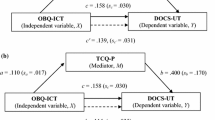Abstract
The volitional suppression of thoughts andrelated increases in intrusions has been posited as amodel for clinical disorders, includingobsessive-compulsive disorder (OCD). Personallyrelevant, negative intrusive thoughts were elicited fromparticipants with OCD and nonclinical (NC) subjects. Thenegative thoughts reported by OCD patients were highlyrelated to core clinical obsessions. Participants with OCD reported more intrusive thoughts than didNC subjects regardless of whether they attempted tosuppress obsessional intrusions. Group- orexperimental-condition related thought enhancement orrebound was not found, but a greater percentage of theOCD suppression group experienced thought rebound thandid the NC suppression group. Volitional thoughtsuppression maybe but one of many response strategies employed by individuals with OCD when negativeintrusive thoughts occur.
Similar content being viewed by others
REFERENCES
American Psychiatric Association (1994). Diagnostic and statistical manual of mental disorders (4th ed.). Washington, DC: Author.
Amir, N., Cashman, L., & Foa, E. B. (1997). Strategies of thought control in obsessive-compulsive disorder. Behaviour Research and Therapy, 35, 775–777.
Beck, A. T., & Steer, R. A. (1987). Beck Depression Inventory manual. San Antonio, TX: The Psychological Corporation.
Brown, T. A., DiNardo, P. A., & Barlow, D. H. (1994). Anxiety disorders interview schedule for DSMIV. Graywind Publications, Incorporated: New York.
Calamari, J. E. & Janeck, A. S. (1998). Intrusive thoughts in obsessive-compulsive disorder: Appraisal differences. Depression and Anxiety, 7, 139–140.
Cioffi, D. & Holloway, J. (1993). Delayed costs of suppressed pain. Journal of Personality & Social Psychology, 64, 274–282.
Clark, D. M., Ball, S. & Pape, D. (1991). An experimental investigation of thought suppression. Behaviour Research and Therapy, 29, 253–257.
Clark, D. M., Winton, E., & Thynn, L. (1993). A further experimental investigation of thought suppression. Behaviour Research and Therapy, 29, 207–210.
Edwards, S. & Dickerson, M. (1987). Intrusive unwanted thoughts: A two-stage mode l of control. British Journal of Medical Psychology, 60, 317–328.
Enright, S. J. (1996). Obsessive-compulsive disorder: Anxiety disorder or schizotype? In R. M. Rapee (Ed.), Current controversies in the anxiety disorders. Guilford: New York.
Freeston, M. H. & Ladouceur, R. (1993). Appraisal of cognitive intrusions and response style: Replication and extension. Behaviour Research and Therapy, 31, 186–191.
Freeston, M. H. & Ladouceur, R. (1997). What do patients do with their obsessive thoughts? Behaviour Research and Therapy, 35, 335–348.
Goodman, W. K., Price, L. H., Rasmussen, S. A., Mazure, C., Fleischmann, R. L., Hill, C. L., Heninger, G. R., & Charney, D. S. (1989). The Yale-Brown Obsessive Compulsive Scale: II. Development, use, and reliability. Archives of General Psychiatry, 46, 1006–1011.
Haaga, D. A. F. & Allison, M. L. (1994). Thought suppression and smoking relapse: A secondary analysis of Haaga (1989). British Journal of Clinical Psychology, 33, 27–331.
Kelly, A. E. & Kahn, J. H. (1994). Effects of suppression of personal intrusive thoughts. Journal of Personality and Social Psychology, 66, 998–1006.
Kirby, K. (1993). Advanced data analysis with SYSTAT. New York: Van Nostrand Reinhold.
Kirk, R. E. (1968). Experimental design: Procedures for the behavioral sciences. Belmont, CA: Brooks/Cole.
Lavy, E. H. & vanden Hout, M. A. (1990). Thought suppression induces intrusions. Behavioural Psychotherapy, 18, 251–258.
McNally, R. J. & Ricciardi, J. N. (1996). Suppression of negative and neutral thoughts. Behavioral and Cognitive Psychotherapy, 24, 17–25.
Merckelbach, H., Muris, P., van den Hout, M. & de Jong, P. (1991). Rebound effects of thought suppression: Instruction dependent? Behavioural Psychotherapy, 19, 225–238.
Muris, P., Merckelbach, H. & de Jong, P. (1993). Verbalization and environmental cuing in thought suppression. Behaviour Research and Therapy, 31, 609–612.
Muris, P., Merckelbach, H., Horselenberg, R., Sijsenaar, M., & Leeuw, I. (1997). Thought suppression in spider phobia. Behaviour Research and Therapy, 35, 769–774.
Muris, P., Merckelbach, H., van den Hout, M. & de Jong, P. (1992). Suppression of emotional and neutral material. Behaviour Research and Therapy, 30, 639–642.
Purdon, C., & Clark, D. A. (1994). Obsessive intrusive thoughts in nonclinical subjects. Part II. Cognitive appraisal, emotional response, and thought control strategies. Behaviour Research and Therapy, 32, 403–410.
Roemer, L., & Borkevec, T. D. (1994). Effects of suppressing thoughts about emotional material. Journal of Abnormal Psychology, 103, 467–474.
Rutledge, P. C., Hancock, R. A., & Rutledge, J. H. (1996). Predictors of thought rebound. Behaviour Research and Therapy, 34, 555–562.
Salkovskis, P. M. (1985). Obsessional-compulsive problems: A cognitive-behavioural analysis. Behaviour Research and Therapy, 23, 571–583.
Salkovskis, P. M. (1989). Cognitive-behavioral factors and the persistence of intrusive thoughts in obsessional problems. Behaviour Research and Therapy, 27, 677–682.
Salkovskis, P. M. & Campbell, P. (1994). Thought suppression induces intrusion in naturally occurring negative intrusive thoughts. Behaviour Research and Therapy, 32, 1–8.
Salkovskis, P. M. & Reynolds, M. (1994). Thought suppression and smoking cessation. Behaviour Research and Therapy, 32, 193–201.
Spielberger, C. D., Gorsuch, R. L., Lushene, R., Vagg, P. R., & Jacobs, G. A. (1983). Manual for the State-Trait Anxiety Inventory (form Y). Palo Alto, CA: Consulting Psychologists Press, Inc.
Trinder, H. & Salkovskis, P. M. (1994). Personally relevant intrusions outside the laboratory: Long term suppression increases intrusion. Behaviour Research and Therapy, 32, 833–842.
Wegner, D. M. (1989). White bears and other unwanted thoughts: Suppression obsession and the psychology of mental control. Guilford Press: New York.
Wegner, D.M. & Gold, D. B. (1995). Fanning old flames: Emotional and cognitive effects of suppressing thoughts of a past relationship. Journal of Personality and Social Psychology, 68, 782–792.
Wegner, D. M., Schneider, D. J., Carter, S. R., & White, T. L. (1987). Paradoxical effects of thought suppression. Journal of Personality and Social Psychology, 53, 5–13.
Wenzlaff, R. M., Wegner, D. M. & Klein, S. B. (1991). The role of thought suppression in the bonding of thought and mood. Journal of Personality and Social Psychology, 60, 500–508.
Wilkerson, L., Blank, G., Gruber, C. (1996). Desktop data analysis with SYSTAT. Upper Saddle River, NJ: Prentice Hall.
Rights and permissions
About this article
Cite this article
Janeck, A.S., Calamari, J.E. Thought Suppression in Obsessive-Compulsive Disorder. Cognitive Therapy and Research 23, 497–509 (1999). https://doi.org/10.1023/A:1018720404750
Issue Date:
DOI: https://doi.org/10.1023/A:1018720404750




